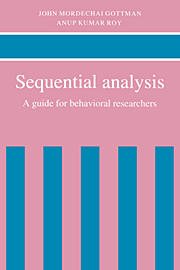Book contents
- Frontmatter
- Contents
- Preface
- Reading this book quickly
- Part I Introduction
- Part II Fitting the timetable
- Part III The timetable and the contextual design
- Chapter 10 Log-linear models
- Chapter 11 Log-linear models: review and examples
- Chapter 12 A single case analysis of the timetable
- Chapter 13 Logit models and logistic regression
- Chapter 14 The problem of autocontingency and its solutions
- Chapter 15 Recent advances: a brief overview
- Chapter 16 A brief summary
- References
- Index
Chapter 13 - Logit models and logistic regression
from Part III - The timetable and the contextual design
Published online by Cambridge University Press: 10 November 2009
- Frontmatter
- Contents
- Preface
- Reading this book quickly
- Part I Introduction
- Part II Fitting the timetable
- Part III The timetable and the contextual design
- Chapter 10 Log-linear models
- Chapter 11 Log-linear models: review and examples
- Chapter 12 A single case analysis of the timetable
- Chapter 13 Logit models and logistic regression
- Chapter 14 The problem of autocontingency and its solutions
- Chapter 15 Recent advances: a brief overview
- Chapter 16 A brief summary
- References
- Index
Summary
Introduction
Logit models are a class of models used to explore the relationship of a dichotomous dependent variable to one or more independent variables. In these models, the logit, or log-odds (i.e., the natural logarithm of the odds), that the dependent variable has a specific given value is analyzed as a linear function of the independent variables. Logit models are analogous to ordinary regression models in which the expected value of a continuous dependent variable is expressed as a linear combination/function of one or more independent variables, in much the same way as hierarchical log-linear models have been earlier shown to be analogs of the analysis of variance (ANOVA) class of models. Generally utilized algorithms for the estimation of logit models exploit such analogy.
As social scientists we are often concerned with the problem of explaining and predicting behavior. Often, the dependent variable that describes behavior is a continuous variable. In that case we can employ standard parametric inferential procedures (like multiple regression analysis), which allow inferences about “average” population behavior given a random sample of data from a population of individuals.
In most observational coding systems, however, the dependent variable is not continuous, but instead is a set of alternatives that are discrete or “quantal.” Efforts to analyze behavior observed as discrete outcomes or events thus involve a class of models with discrete, or qualitative, dependent variables. Such models are generally referred to in the social science literature as “quantal choice models” or “quantal response analysis.”
- Type
- Chapter
- Information
- Sequential AnalysisA Guide for Behavorial Researchers, pp. 189 - 227Publisher: Cambridge University PressPrint publication year: 1990

